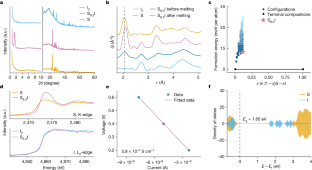2024-03-06 カリフォルニア大学サンディエゴ校(UCSD)
<関連情報>
- https://today.ucsd.edu/story/healable-cathode-could-unlock-potential-of-solid-state-lithium-sulfur-batteries
- https://www.nature.com/articles/s41586-024-07101-z
固体Li-S電池のための修復可能で導電性のヨウ化硫黄 Healable and Conductive Sulfur Iodide for Solid-State Li-S Batteries
Jianbin Zhou,Manas Likhit Holekevi Chandrappa,Sha Tan,Shen Wang,Chaoshan Wu,Howie Nguyen,Canhui Wang,Haodong Liu,Sicen Yu,Quin R. S. Miller,Gayea Hyun,John Holoubek,Junghwa Hong,Yuxuan Xiao,Charles Soulen,Zheng Fan,Eric E. Fullerton,Christopher J. Brooks,Chao Wang,Raphaële J. Clément,Yan Yao,Enyuan Hu,Shyue Ping Ong & Ping Liu
Nature Published:06 March 2024
DOI:https://doi.org/10.1038/s41586-024-07101-z

Abstract
Solid-state Li–S batteries (SSLSBs) are made of low-cost and abundant materials free of supply chain concerns. Owing to their high theoretical energy densities, they are highly desirable for electric vehicles1,2,3. However, the development of SSLSBs has been historically plagued by the insulating nature of sulfur4,5 and the poor interfacial contacts induced by its large volume change during cycling6,7, impeding charge transfer among different solid components. Here we report an S9.3I molecular crystal with I2 inserted in the crystalline sulfur structure, which shows a semiconductor-level electrical conductivity (approximately 5.9 × 10−7 S cm−1) at 25 °C; an 11-order-of-magnitude increase over sulfur itself. Iodine introduces new states into the band gap of sulfur and promotes the formation of reactive polysulfides during electrochemical cycling. Further, the material features a low melting point of around 65 °C, which enables repairing of damaged interfaces due to cycling by periodical remelting of the cathode material. As a result, an Li–S9.3I battery demonstrates 400 stable cycles with a specific capacity retention of 87%. The design of this conductive, low-melting-point sulfur iodide material represents a substantial advancement in the chemistry of sulfur materials, and opens the door to the practical realization of SSLSBs.



